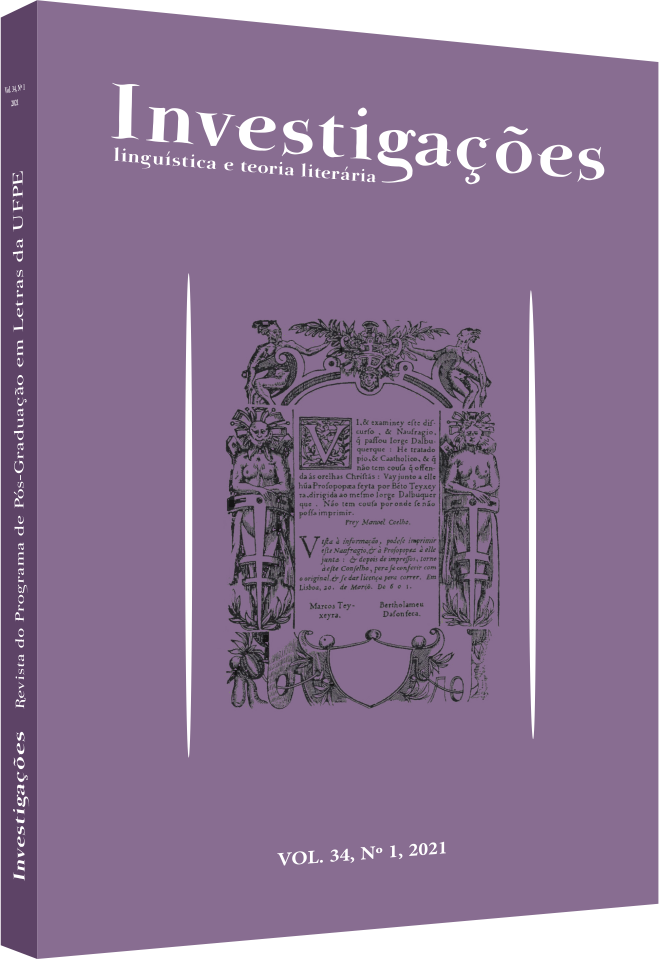Entre a passarola e a flor: imagens e contrastes na construção solidária de uma nova humanidade
DOI:
https://doi.org/10.51359/2175-294x.2021.250545Keywords:
historiographic metafiction, José Saramago, comparative literature, children’s literature.Abstract
This article examines the possibility of similar methods and motivations in narratives written for adults and children by José Saramago, through the comparison of the themes and formal aspects in Baltasar and Blimundaand The Biggest Flower in the World. The style is primarily examined concerning the narration full of interventions and suggestions, as well as the strategies used at the beginning of the texts. Then, the human will is identified as the conductor towards a higher and more equal destiny for a world in bewilderment.References
AGUILERA, Fernando Gómez. A Consistência dos Sonhos. São Paulo: Instituto Tomie Ohtake, 2008.
AGUILERA, Fernando Gómez. As palavras de Saramago. 1 ed. São Paulo: Companhia das Letras, 2010.
ANDRADE, Carlos Drummond de. A rosa do povo. São Paulo: Editora Companhia das Letras, 2012.
BASTO, Artur de Magalhães. Porto e Brasil: Figuras e Factos da História Luso Brasileira. Porto: Progredior, 1946.
BÍBLIA. Português. Sagrada Bíblia Católica: Antigo e Novo Testamentos. Tradução de José Simão. São Paulo: Sociedade Bíblica de Aparecida, 2008.
CIRLOT, Juan Eduardo. Dicionário de Símbolos. Tradução de Rubens Eduardo Ferreira Frias. São Paulo: Centauro, 2005.
FERREIRA, Joaquim. História de Portugal. Porto: Editorial Domingos Barreira,1951.
HUTCHEON, Linda. Poética do Pós-modernismo. Tradução de Ricardo Cruz. Rio de Janeiro: Imago Editora, 1991.
KAUFMAN, Helena. A metaficção historiográfica de José Saramago. Colóquio/Letras, Lisboa, n. 120, p. 124-136, abr. 1991.
MARTINS, Manuel Frias. A espiritualidade clandestina de José Saramago. Lisboa: Fundação José Saramago, 2014.
MOISÉS, Massaud. A literatura portuguesa. São Paulo: Editora Cultrix, 2006.
SARAMAGO, José. A maior flor do mundo. Ilustrações de João Caetano. São Paulo: Companhia das Letrinhas, 2001.
SARAMAGO, José. As pequenas memórias. São Paulo: Companhia das Letras, 2006.
SARAMAGO, José. Ensaio sobre a cegueira. São Paulo: Companhia das Letras, 1995.
SARAMAGO, José. O homem faz-se a si próprio. Entrevista concedida a Rodrigues Silva. Jornal de Letras, Artes e Ideias, Lisboa. Seção Tema, p. 11-14, abr. 1997.
SARAMAGO, José. Memorial do Convento. 27. ed. Rio de Janeiro: Bertrand Brasil, 2002.
SARAMAGO, José. O Conto da Ilha Desconhecida. São Paulo: Companhia das Letras, 1998.
SARAMAGO, José. O Evangelho segundo Jesus Cristo. São Paulo: Companhia das Letras, 2008.
SARAMAGO, José. O Memorial do Convento, de José Saramago: Apontamentos. Portugal, 1986.
(Depoimento concedido a Mário Ventura). Disponível em: . Acesso em 14 mar. 2021.
______. O Tempo e a História. Évora: Universidade de Évora, 1999.
______. Os poemas possíveis. Lisboa: Caminho, 1982.
Downloads
Published
How to Cite
Issue
Section
License
Copyright (c) 2021 Valéria Hernandorena Monteagudo de Campos

This work is licensed under a Creative Commons Attribution 4.0 International License.
Authors who publish with Revista Investigações agree to the following terms:
Authors retain copyright and grant the journal right of first publication with the work simultaneously licensed under the Creative Commons Attribution 4.0 International (CC BY 4.0) license that allows others to share the work with an acknowledgement of the work's authorship and initial publication in this journal.
Authors are able to enter into separate, additional contractual arrangements for the non-exclusive distribution of the journal's published version of the work (e.g., post it to an institutional repository or publish it in a book), with an acknowledgement of its initial publication in this journal.
You are free to:
Share — copy and redistribute the material in any medium or format for any purpose, even commercially.
Adapt — remix, transform, and build upon the material for any purpose, even commercially.
The licensor cannot revoke these freedoms as long as you follow the license terms.
Under the following terms:
Attribution — You must give appropriate credit , provide a link to the license, and indicate if changes were made . You may do so in any reasonable manner, but not in any way that suggests the licensor endorses you or your use.
No additional restrictions — You may not apply legal terms or technological measures that legally restrict others from doing anything the license permits.

